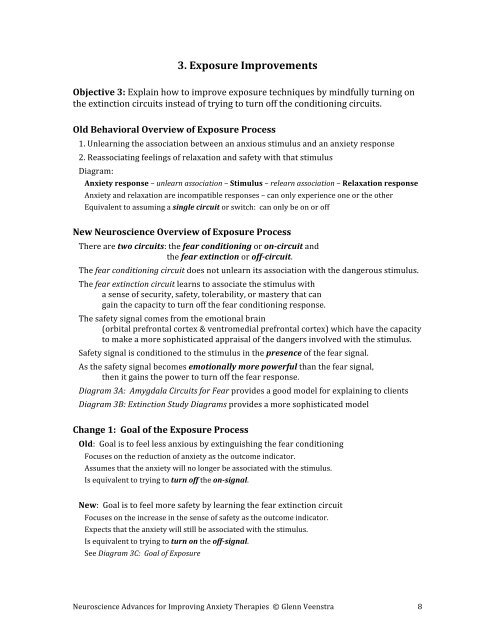Veenstra 170 - Anxiety Disorders Association of America
Veenstra 170 - Anxiety Disorders Association of America
Veenstra 170 - Anxiety Disorders Association of America
Create successful ePaper yourself
Turn your PDF publications into a flip-book with our unique Google optimized e-Paper software.
3. Exposure Improvements<br />
Objective 3: Explain how to improve exposure techniques by mindfully turning on<br />
the extinction circuits instead <strong>of</strong> trying to turn <strong>of</strong>f the conditioning circuits.<br />
Old Behavioral Overview <strong>of</strong> Exposure Process<br />
1. Unlearning the association between an anxious stimulus and an anxiety response<br />
2. Reassociating feelings <strong>of</strong> relaxation and safety with that stimulus<br />
Diagram:<br />
<strong>Anxiety</strong> response – unlearn association – Stimulus – relearn association – Relaxation response<br />
<strong>Anxiety</strong> and relaxation are incompatible responses – can only experience one or the other<br />
Equivalent to assuming a single circuit or switch: can only be on or <strong>of</strong>f<br />
New Neuroscience Overview <strong>of</strong> Exposure Process<br />
There are two circuits: the fear conditioning or on-‐circuit and<br />
the fear extinction or <strong>of</strong>f-‐circuit.<br />
The fear conditioning circuit does not unlearn its association with the dangerous stimulus.<br />
The fear extinction circuit learns to associate the stimulus with<br />
a sense <strong>of</strong> security, safety, tolerability, or mastery that can<br />
gain the capacity to turn <strong>of</strong>f the fear conditioning response.<br />
The safety signal comes from the emotional brain<br />
(orbital prefrontal cortex & ventromedial prefrontal cortex) which have the capacity<br />
to make a more sophisticated appraisal <strong>of</strong> the dangers involved with the stimulus.<br />
Safety signal is conditioned to the stimulus in the presence <strong>of</strong> the fear signal.<br />
As the safety signal becomes emotionally more powerful than the fear signal,<br />
then it gains the power to turn <strong>of</strong>f the fear response.<br />
Diagram 3A: Amygdala Circuits for Fear provides a good model for explaining to clients<br />
Diagram 3B: Extinction Study Diagrams provides a more sophisticated model<br />
Change 1: Goal <strong>of</strong> the Exposure Process<br />
Old: Goal is to feel less anxious by extinguishing the fear conditioning<br />
Focuses on the reduction <strong>of</strong> anxiety as the outcome indicator.<br />
Assumes that the anxiety will no longer be associated with the stimulus.<br />
Is equivalent to trying to turn <strong>of</strong>f the on-‐signal.<br />
New: Goal is to feel more safety by learning the fear extinction circuit<br />
Focuses on the increase in the sense <strong>of</strong> safety as the outcome indicator.<br />
Expects that the anxiety will still be associated with the stimulus.<br />
Is equivalent to trying to turn on the <strong>of</strong>f-‐signal.<br />
See Diagram 3C: Goal <strong>of</strong> Exposure<br />
Neuroscience Advances for Improving <strong>Anxiety</strong> Therapies © Glenn <strong>Veenstra</strong> 8


